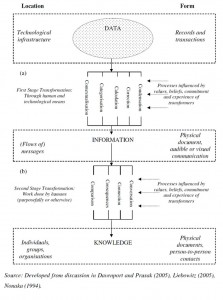Dec 20, 2009
Data, Information, Knowledge (notes)
Data, Information, Knowledge (NOTES)
Although knowledge shares a close relationship with data and information, it is recognised that the three are significantly different concepts (Davenport and Prusak, 2005; Gurteen, 1998; Nguyen, 2002). The consequences of not recognising the differences have been borne out in failed knowledge management initiatives and over-expenditure (Davenport and Prusak, 2005; Liebowitz, 2001).
Gurteen (199 uses the metaphor of baking a cake to illustrate the difference; from the molecular constituents of the cake (data), to the list of ingredients (information), through to the recipe (explicit knowledge), being able to make a good cake from the recipe (tacit knowledge).
The literature (Davenport and Prusak, 2005; Gurteen, 1998; Leonard and Sensiper, 1998; Liebowitz, 2001; Nguyen, 2002; Nonaka, 1994; Nonaka and Takeuchi, 1995) describes the relationship in the following way (see Figure 4);
Figure 4: Data, Information and Knowledge
- Data (top of Figure 4): “Data is a set of discrete, objective facts about events” that in an organisational context usually resides in company records and archives through a technological infrastructure. While it is created and stored in a context, data itself does not provide judgement or interpretation (Davenport and Prusak, 2005: 302).
- Information (middle of Figure 4): Information can be seen as patterned and relevant in physical, audible or visual form, and knowledge as the ability to act on that information (Davenport and Prusak, 2005; Liebowitz, 2001). Information is ‘value-added’ data, that is, data that has in some way been altered to provide utility, meaning and context. Davenport and Prusak (2005) note that in becoming information (refer to Figure 4(a)), data can be (1) put into context (contextualisation), (2) put into categories (categorisation), (3) analysed in a statistical or mathematical way (calculation), (4) cleansed of errors (correction) and (5) put into a more brief, summarised form (condensation) by machines and humans.
- Knowledge (bottom of Figure 4): Just as data becomes information, information becomes knowledge. Davenport and Prusak (2005) suggest that this happens through (1) comparison with other situations and information, (2) evaluation of the consequences of the information (what action the information implies), (3) the making of connections and the recognition of relationships with other information, and (4) finding out others’ views (conversation) (Figure 4(b)). These four processes are performed (consciously or not) by humans, whose actions are founded on commitment, beliefs, values and experience (Leonard and Sensiper, 1998; Nonaka, 1994; Nonaka and Takeuchi, 1995). A definition that recognises the intricacies and constituents of knowledge states that;
“Knowledge is a fluid mix of framed experiences, values, contextual information, and expert insight that provides a framework for evaluating and incorporating new experiences and information. It originates and is applied in the minds of knowers. In organizations, it often becomes embedded not only in documents or repositories but also in organizational routines, processes, practices, and norms.” (Davenport and Prusak, 2005: 305).
References:
Davenport, T.H. and Prusak, L. (2005). What do we talk about when we talk about knowledge? In I. Nonaka (ed.) Knowledge management: critical perspectives on business and management, 301-321. New York: Routledge.
Gurteen, D. (1998). Knowledge, creativity and innovation. Journal of Knowledge Management, 2(1), 5-13.
Leonard, D. and Sensiper, S. (1998). The role of tacit knowledge in group innovation. California Management Review, 40(3), 112-132.
Liebowitz, J. (2001). Knowledge management and its link to artificial intelligence. Expert Systems with Applications, 20, 1-6.
Nguyen, T.V. (2002). Knowledge management: literature review and findings about perceptions of knowledge transfer in collaborative and process-oriented teams. Pepperdine University. Doctor of Education in Organizational Leadership Dissertation: 227 pages.
Nonaka, I. (1994). A dynamic theory of organizational knowledge creation. Organization Science, 5(1), 14-37
Nonaka, I. and Takeuchi, H. (1995). The knowledge creating company. New York: Oxford University Press.

